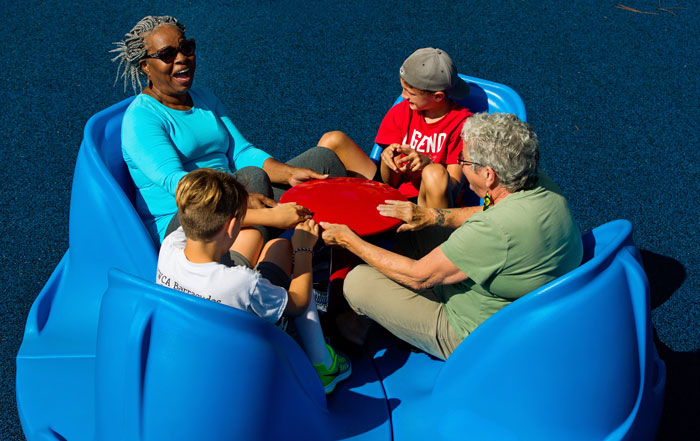As we go about our day-to-day tasks, I’m sure I’m not the only one who sometimes passes a modern playground and thinks, “Wow, I wish I was a kid—that place looks awesome!” And as adults, we’ve learned that play is more than simply having fun; it’s crucial to all kids for their physical, social, emotional and cognitive development. So we checked in with those whose work is play, to get some insights into playground design trends.
Kent Callison, the marketing director for a Ft. Payne, Ala.-based designer and manufacturer of commercial playground equipment, discussed how they recently surveyed 1,600 people working in parks and rec departments nationwide, examining trends and challenges. “Regarding trends, most respondents indicated intergenerational recreation is the trend they follow closely. Parks professionals want to create spaces where families can play together—parks and playgrounds that attract multiple generations and offer amenities that appeal to all ages.”
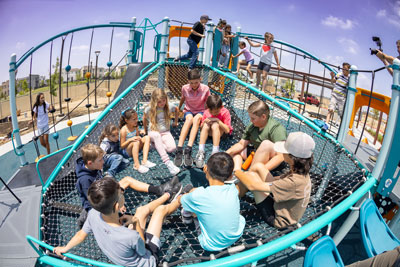
“Intergenerational play is a trend we see communities embracing,” said Sarah Lisiecki, communications and education manager for a Fond du Lac, Wis.-based company that designs and manufactures commercial playground equipment. “People of all ages and abilities need to be outdoors for mental and physical health. Gathering spaces that provide entertainment for everyone get the most support and encourage community pride and engagement.”
She mentioned outdoor musical instruments, games such as gaga ball and outdoor fitness equipment as examples of ways to design for intergenerational play.
Lisiecki added that inclusive play design and the use of universal design principles is a trend that keeps evolving into better products and designs. “Creating spaces that are useable for everyone allows all people to get the benefits of play and recreation in a way that is comfortable for them.”
Scott Roschi, creative director for a Delano, Minn.-based designer and manufacturer of commercial playground equipment, agreed that there’s a strong emphasis on designing inclusive, multigenerational spaces. “Playgrounds are evolving to accommodate children of all abilities, while also catering to older children and even adults through fitness stations and dynamic play features.”
Additionally, “There’s a growing trend toward using natural materials and designs that blend more seamlessly into their surroundings, encouraging more imaginative and open-ended play.”
“One of the most exciting aspects of working in this industry is that playground design continues to evolve, finding new ways to engage and excite children,” said David Sheedy, vice president of sales for a Lewisburg, Pa., designer and manufacturer of commercial playground equipment, agreeing that there’s a greater emphasis on inclusivity and connection to natural environments. “There’s also a shift toward dynamic, flexible designs as a response to the increasing demand for playgrounds that promote physical, sensory and cognitive development in more engaging ways.
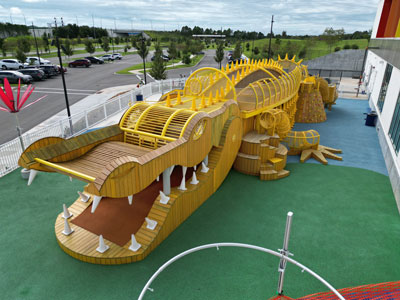
“One of the most significant trends is the rise of ‘hill play,’ where natural or manufactured slopes are integrated into playground designs,” continued Sheedy. “These features encourage children to engage dynamically with the environment—climbing, sliding and exploring different physical challenges while promoting creative, unstructured play.”
He described their collection comprised of five climbing trails that “challenge kids in different ways.” These challenge strength, coordination and creativity, featuring climbing ropes, nets, steel rails, hand and footholds, angular grips and tri-mounds, he explained, while also providing for social and sensory play.
Larger, visually captivating structures with myriad features continue to be popular, and Callison pointed out how much people love towers. “They’re so cool, and think back to when you were a kid—the higher you could climb, the more exciting play was. The key is ensuring these towers meet standards, offering enclosed areas at higher elevations, and always including the appropriate playground surfacing.”
Callison said they offer preconfigured and custom tower designs, and now have an inclusive tower as well. “It includes these amazing accessible routes all the way to the top of a 14-foot-tall tower.”
He mentioned that Bill Botten—formerly of the U.S. Access Board and “one of the key people who helped develop the Americans with Disabilities Act,” consulted with them during the tower’s development.
“Larger, more complex play structures like towers are becoming increasingly popular,” said Roschi. He described one of their towers, and said the “geometric, multifaceted play system presents opportunities for climbing, balancing and sliding from various angles. Its modular design promotes a continuous flow of play, allowing children to explore different routes, interact with others and engage in both physical and imaginative play.” Additionally, the tower’s unique shape and interconnected layers promote “problem solving and cooperative play,” encouraging developmental growth.
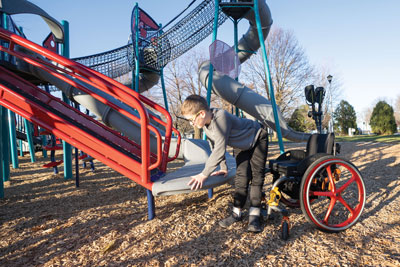
Lisiecki said another big trend they’re witnessing is adventure, which “helps children develop resilience, manage emotions and take age-appropriate risks. Tall towers, rope tunnels, fast slides and exciting climbers are some play events that bring a sense of adventure to the playground.”
She pointed out that adventure play has a high replay value, and said they’ve been studying bringing awe and adventure into our daily lives, which can “bring us calm. Designing for awe and adventure is important to both our physical and mental health and helps the outdoors compete for time with screens.”
“Adventure play frequently features structures like rope and net bridges and balance beams that enable children to participate in physical activities that enhance strength, balance, agility and coordination in a fun and stimulating manner,” said Tammy Raymond, marketing director for a Colchester, Conn.-based company providing custom netting for adventure parks and playgrounds. She said this equipment can be “seamlessly added into any size recreational space, with the flexibility to gradually add more.
“Rope and netting structures continue to be a focal point at playgrounds,” she continued. “It provides many benefits, including freedom of play and creativity. They teach children about physical coordination and balance while encouraging physical activity.”
She said it’s common for customers to have a mix of standard pieces and custom-designed structures. “For example, custom cargo climbing nets can span great distances or heights. These might be tailored to fit between two existing structures or elevated platforms in unique ways. Another project may be a park requesting nets that resemble spider webs or treetop canopies, encouraging kids to explore ‘natural’ play.”
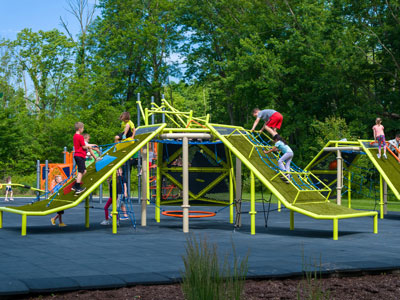
Raymond mentioned themed playgrounds as a trend, as they “offer a unique and imaginative play experience that can attract large crowds. These custom designs add to the storytelling aspect of the playground, making play even more engaging.”
She described one impressive net play structure, a “larger-than-life alligator for children to explore,” located outside the Florida Children’s Museum in Lakeland, Fla. Blinky the alligator is the museum’s mascot, utilized in social media posts.
“There’s been an enormous demand for playground nets in the last five years,” said Callison. “People want small nets, large nets, tall nets that loop around, nets that tower way up into the sky and nets that spin.” He mentioned how they introduced nets that “include a transfer platform and accessible routes to a slide so everyone can play on the playground nets together.”
And when it comes to theming and custom projects, Callison said that personalizing a playground is commonplace now. He explained how their in-house design studio “seeks ways to tell a community’s story, highlighting its history, geography and culture.”
As an example, he mentioned how a massive dinosaur fossil was found in Austin, Texas, in 1935, and the community wanted to re-create the event. So a dinosaur head was sculpted—large enough for kids to stand in—and the body was created from steel and nets for a “unique climbing experience. We design rocket ships and pirate ships, treehouses and forest cabins—anything the customer can imagine, we can bring to life.”
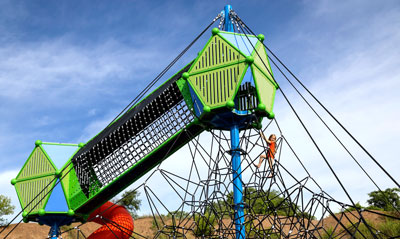
“Customization is absolutely becoming more of a priority for school and community playgrounds as it allows for creativity and uniqueness,” said Sheedy. “Whether it’s designing spaces around natural features, a mascot or elements that commemorate a special moment or highlight a community’s history, many customers want a playground reflective of their location.”
He described how they created and donated a custom first responder-themed playground to their hometown for those who extinguished a fire at their factory. “It was a moment—for us and this town—that absolutely deserved recognition.”
Roschi agreed that custom playground designs are “becoming more prevalent as communities seek to reflect their local culture, history or unique environment in these spaces.”
He described their Domino Park project in New York, inspired by the iconic Domino sugar factory once housed there and designed by an artist who researched the site. Stainless-steel slides resemble industrial pipes, and an intricate web of belting, nets and climbers lets kids scramble from the sugar shack up to the masher tower and over to the centrifuge. The design makes it a “one-of-a-kind destination that resonates deeply with those who use it.”
Play variety is an important design consideration, according to Lisiecki, as is replay value, meaning that the “play experience is layered and dynamic, so kids want to come back again and again.”
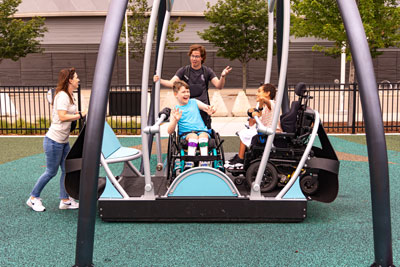
She cited electronic play as an example, and mentioned their electronic game that’s powered by people, suitable for all ages, abilities and levels, that tests fitness, agility and speed. “There’s incentive to come back, try new games, play with different children or try to beat your own individual score.”
She pointed out that including electronic play, musical play and educational play products fosters socialization, cognitive growth and independence in children, an important part of their development. “Play is learning. And child-directed, independent learning is something many children really enjoy.”
Many studies have shown the importance of spending time in nature, according to Callison, with children and adults realizing social, cognitive and emotional benefits when playing outdoors. He explained how they partnered with the Natural Learning Initiative at N.C. State to develop a guide to creating play spaces that integrate manufactured play equipment into the natural landscape. Sometimes called “natural playgrounds,” these spaces “help children and families reconnect with nature. The result is a more comfortable, inviting and overall richer recreation experience.”
Revisiting the parks department survey recently conducted by Callison’s company, when it came to trends, the second highest response involved outdoor fitness spaces and programming. He related that one of the many scholars their parent company enlisted to help develop exercise programming—Dr. Michael Suk—once said “An effective way to prevent childhood obesity is to reverse adult obesity.” So, if you create spaces that help adults set the right example, kids may learn from that example.

To that end, “We design outdoor fitness equipment for adults that can be installed on trails, pathways or adjacent to playgrounds,” said Callison. This helps adults to get a workout while children are playing nearby, plus kids can see examples the adults have set.
Additionally, as communities desire intergenerational recreation, his company introduced their obstacle course variations to “create a playground concept for adults and children. People love this friendly and social kind of competition, and it’s created an entirely new type of outdoor recreation for communities.”
Lisiecki agreed that obstacle courses are a great way to bring people together for exercise and “also provide places for people to exercise as a family and community.”
She said their fitness courses have different levels of challenge, “which is important so everyone can get the workout they need, and there are instructional videos on an app that has your specific course layout and the different ways to use it.”
Looking at another exciting feature born out of adventure parks, “Zip lines are rapidly gaining popularity as a must-have feature in playgrounds,” said Roschi. He mentioned their zip line product that offers a two-way, back-and-forth ride, which “provides more rides for more kids but also reduces wait times.”
Their assisted zip line model features a molded bucket seat with lock-in-place harness. “With the addition of multiple bays and assisted options, zip lines are becoming more inclusive, allowing all kids to join in the fun.”
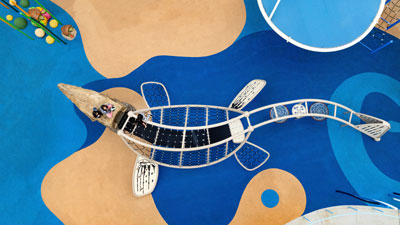
In fact, as touched on earlier, all our contributors strive for inclusive designs and offer inclusive playground components. “There’s a growing emphasis on inclusivity and accessibility in playground design today, with clients increasingly prioritizing spaces where children of all abilities can play together,” said Roschi. He mentioned their inclusive swing and merry-go-round products as examples, which “help to create environments where every child can engage in meaningful play.”
“Parks departments, schools, churches and other markets increasingly understand that inclusive playgrounds provide kids of all abilities the chance to play,” said Sheedy. “They want to build a play space that’s welcoming to all or revamp their current play space to allow more kids access.”
He said their Inclusive Play Training Course is “research-based and offers a real-world grounding in principles based in child development and inclusive best practices.”
Callison pointed out that in the United States alone, more than 7 million people between the ages of 3 and 21 have some type of disability: physical, cognitive, sensory, medical etc. “That’s the population of the state of Tennessee. Imagine an entire state’s population of people who want to play but aren’t able to because the playground in their community doesn’t address their needs.” Therefore, he said they design parks and playgrounds using “best-practice research from leading scholars and designers” to create “true equity where everyone realizes the same fun and benefits to the greatest extent possible.”
While inclusion is a priority for many reasons, at the base level, it’s the law, according to Lisiecki. “ADA requirements state that access to public recreation is a civil right.”
But it’s also important because “we know that play is a catalyst for learning, growing, developing and engaging in the community.” She mentioned a few trends that address this critical consideration, including providing parallel pathways for play, offering play variety and providing play equity. “Providing all children access to the most used and exciting aspects of play is an important part of equity.”
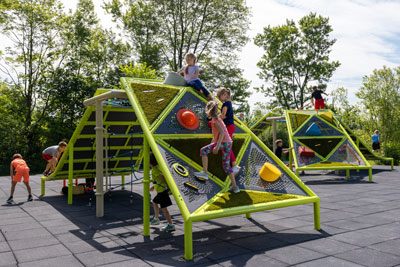
When considering new playground designs, Callison said the “discovery phase” is essential. They examine the site and “how best to incorporate play and recreation equipment. Maybe there are hills that we can use for hillside slides or a forested area where we can add net tunnels for children to explore the tree canopy. We always consider what the community needs now and what it might need decades from now.”
Sheedy reminded us that a great playground is about more than the equipment. “Ensuring there is ample shade and space to sit and relax are key factors to include when planning. Other non-play features that should not be overlooked are fencing and surfacing, as parents rightfully demand that their kids play safely and securely.”
“Communities want playgrounds to serve as gathering spaces for families and neighbors,” added Roschi, “so comfortable, well-placed benches, tables and shade structures are a priority.”
He said that by collaborating on the design of these spaces, landscape architects and communities are “working hand-in-hand to create genuine gathering places where play serves as the focal point. Whether it’s a casual day at the park or a celebration of a major milestone, these thoughtfully designed parks become the true heart of the community, bringing people together and enriching everyday experiences.” RM



